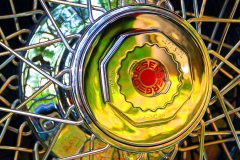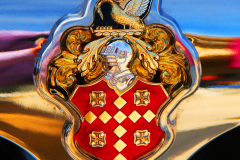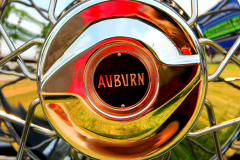Auburn | Cord | Duesenberg
Auburn, Cord and Duesenberg came to be known for their advance engineering, performance and beautiful Art Deco styling. The Rich and Famous owned these cars around the world – they were a symbol for success.
The Auburn Automobile Company grew out of the Eckhart Carriage Company, founded in Auburn, Indiana, in 1874 by Charles Eckhart and his sons Frank and Morris. Auburn expanded, absorbing two other local carmakers and moving into a larger plant in 1909. The enterprise was modestly successful until materials shortages during World War I forced the plant to close.
The 1904 Auburn was a touring car model, equipped with a tonneau cover.
In 1919 new owners revived the business but failed to realize their anticipated profits. In 1924 Auburn output was down to six cars a day so the owners approached Errett Lobban Cord (a highly successful automobile salesman), with an offer to run the company. Cord countered with an offer to take over the company completely. Cord aggressively marketed the company’s unsold inventory and completed his buyout before the end of 1925.
The first Auburn Eight was launched in 1925, and renamed the Auburn 8-88 in 1926.
The most famous model the Auburn Boattail Speedster 851 (1935-37) could top 100 mph making it a popular model in the Hollywood market.
Duesenberg Motors Company (referred to as “Duesy”) was an American manufacturer of race cars and luxury automobiles. It was founded by brothers August and Frederick Duesenberg in 1913 in Saint Paul, Minnesota and moved to Indianapolis, Indiana in 1919.
Their first passenger car, the Duesenberg Model A (1921-1927), was powered by the Duesenberg Straight-8 engine, the first “mass-produced” straight eight in the U.S. It was extremely advanced with features such as single overhead camshafts, four-valve cylinder heads, and the first four-wheel (16″) hydraulic brakes offered on a passenger car. It was lighter and smaller than the competition and was among the most powerful and the fastest cars of its time
The Duesenberg Model X (1926-1927) is a sportier version of the model A with a heavier and longer wheelbase. The Model X is very rare, only 13 were built, and only 4 were known to survive, until Jay Leno found a fifth X in a neighborhood garage in 2005.
In 1926, Errett Cord, now the owner of Auburn, partnered with Duesenberg and used it as the launching platform for a line of high-priced luxury vehicles. The new company was renamed Duesenberg, Inc.
The first model under the new ownership was the Duesenberg Model-J and derivatives (1926-1937), intended to rival the size, power, and luxury of top European brands such as Hispano-Suiza, Isotta Fraschini and Rolls-Royce. The Model J quickly became one of the most popular luxury cars as well as a status symbol in the United States and Europe.
Cord branded vehicles were also developed. The Cord L-29 (1929-1932) was the first American front-wheel drive car to be offered to the public. It was competitively priced with Cadillac, Marmon, Lincoln, Packard, Franklin, and Stutz.
The Cord 810/812 (1936-1937) was the first car with hidden headlamps and featured front-wheel drive, independent front suspension, and a four-speed electrically-selected semi-automatic transmission, It is probably the best-known Cord model due to the flat front nose with louvered grille design (often called the “Coffin Nose”).
Revivals of the Cord 812 in the early 1940s – the Hupmobile Skylark and Graham Hollywood – were unremarkable.
Unfortunately styling and imaginative engineering failed to overcome the fact that Cord’s vehicles were too expensive for the Depression-era market and the company ultimately ceased production in 1937.
The company’s Art Deco headquarters in Auburn now houses the Auburn Cord Duesenberg Automobile Museum.
These cars are now very valuable and can be seen at major car events such as Amelia Island Concours d’Elegance and Pebble Beach Concours d’Elegance.



